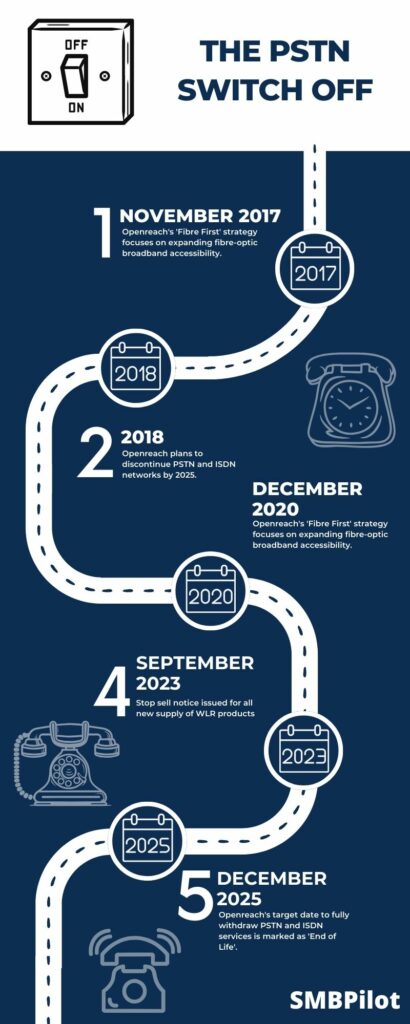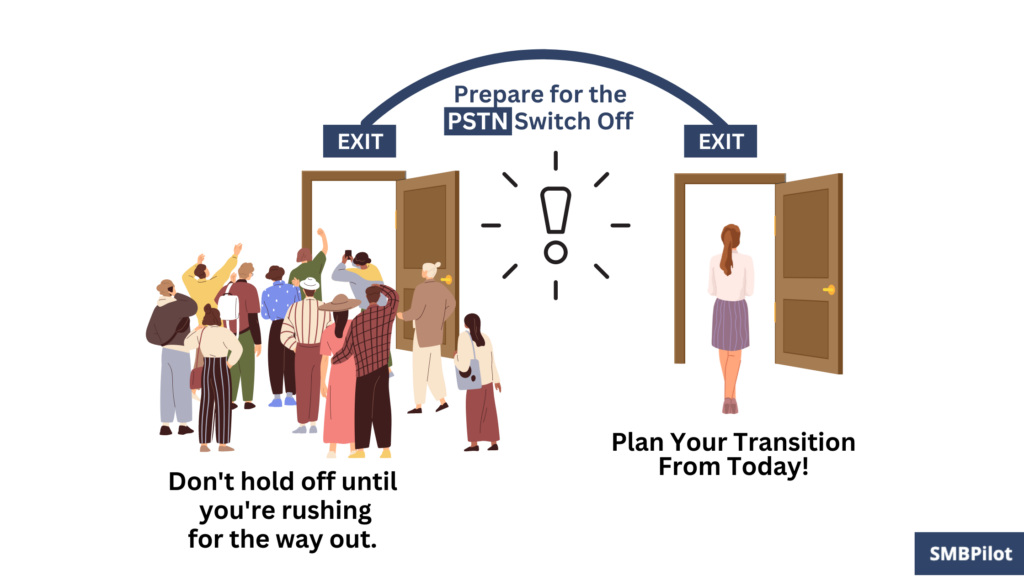Ready or not, the future of telecommunication is knocking at your door – and it’s coming in 2025!” This isn’t just another tech update; it’s a monumental shift in communication. As experts who have rigorously tested over 20 products and scoured countless Reddit threads and forums, we’re here to guide you through this transformative journey. The 2025 Analogue Phone Switch Off marks the end of an era for the traditional landline, but fear not, the dawn of digital communication promises a brighter, more connected future.
Why should you care about this switch? Imagine crystal-clear calls, faster connections, and many new features at your fingertips. The transition from analogue to digital telephony, driven by the adoption of VoIP (Voice over Internet Protocol), isn’t just a technical upgrade; it’s a gateway to a world where your phone line does more than just voice calls. Enhanced security, integrated communication services, and the sheer convenience of a unified digital system are just the tip of the iceberg. And let’s not forget – this switch could significantly reduce your telecommunication costs!
Now, picture this: You’re seamlessly connected, whether working from home, managing your smart home devices, or keeping in touch with friends and family across the globe. This is not a distant dream; the reality awaits post-2025. Our comprehensive research and testing have led us to a curated selection of the best devices and services that make this transition smooth and enrich your digital communication experience. We’ve sifted through the noise to bring you the cream of the crop, ensuring you’re equipped with nothing but the best.
So, what’s next? It’s time to embrace the change. Visit our website for an exclusive look at our top picks for the best VoIP-compatible devices and services tailored to your needs. Don’t let the 2025 switch-off catch you off guard. Let us help you step confidently into the future of communication – a clearer, faster, and smarter future. Remember, the future waits for no one, and the clock is ticking towards 2025. Switch to digital with us and experience communication like never before!

Understanding the Digital Switchover 2025: Transitioning to VoIP and Future-Proofing Your Communication Systems
The Digital Switchover 2025 is a major update in the UK’s telecommunications infrastructure, where all analogue phone lines will transition to digital, internet-based services like Voice over Internet Protocol (VoIP). Announced in 2016, this change affects anyone using a landline at home or in a business setting.
This transition requires users to switch from traditional Public Switched Telephone Network (PSTN) systems to digital solutions. VoIP is a key alternative, utilising the internet for phone services, offering clearer calls and additional features beyond what current landline technology can provide.

Openreach, a BT Group company responsible for the UK’s phone and broadband lines, will complete this switchover by 2025. Considering this timeline, it’s advisable for users
VoIP services boast numerous advantages over traditional landlines, including various features that can enhance business operations. While the benefits of switching to VoIP are clear, it’s important to weigh the pros and cons, which we’ll delve into later. The primary driver for this shift is the need to modernise and improve the efficiency and capabilities of our communication systems.
What are PSTN and ISDN?
PSTN (Public Switched Telephone Network) and ISDN (Integrated Services Digital Network) are fundamental technologies in the realm of telecommunication, each playing a crucial role in the evolution of phone systems.
PSTN is the original telephone network system, primarily composed of copper wires. It was designed for analogue voice communication and has been the standard for telephone services for many years. PSTN operates on a network of interconnected circuits, enabling traditional voice calls over long distances.
ISDN, on the other hand, was introduced within the PSTN framework in the late 1980s. It represents a significant advancement in telecommunication technology, offering a digital version of the analogue phone line. ISDN allows for simultaneous voice and data transfer over the same PSTN copper lines. This was a revolutionary development at the time as it provided faster and more reliable data transmission and higher-quality voice calls compared to the older analogue systems.
| Characteristic | ISDN | PSTN |
|---|---|---|
| Transmission Type | Digital | Analog |
| Data Speed | Up to 128 Kbps | Up to 56 Kbps |
| Call Establishment | Quicker | Slower |
| Signal Clarity | Higher | Lower |
| Channel Capacity | Up to 30 (Europe), 23 (US) | 1 |
| Concurrent Calls | Multiple | Single |
| Caller Identification | Available | Available |
| Call Divert | Supported | Supported |
| Call Hold | Supported | Supported |
| Conference Calling | Available | Available |
| Expense | More Expensive | Less Expensive |
| Coverage | Limited in Certain Regions | Broadly Accessible |
| Best Suited For | Ideal for businesses needing fast data exchange. | Best for home use and basic voice services. |
What are SIP and VoIP?
VoIP (Voice over Internet Protocol) and SIP (Session Initiation Protocol) are key technologies in modern digital communication, especially in Internet-based telephony.
SIP, or Session Initiation Protocol, is a signalling protocol used for initiating, maintaining, modifying, and terminating real-time sessions that involve video, voice, messaging, and other communications applications and services between two or more endpoints on IP networks. Essentially, SIP is a protocol used in VoIP communications that manages the setup and control of voice or video calls over the Internet. It enables different devices and applications to “communicate” with each other, setting up, managing, and terminating calls or multimedia sessions.
VoIP stands for Voice over Internet Protocol. This technology enables voice calls over the internet rather than through traditional wired telephone systems like PSTN and ISDN. In VoIP, the speakers’ voices are converted into digital data packets. These packets are then transmitted across the internet, allowing for voice communication. The key advantage of VoIP is its ability to use the existing internet infrastructure for voice calls, which can significantly reduce costs and increase flexibility in communication. It also allows for the integration of voice communication with other internet-based services.
| Feature | SIP (Session Initiation Protocol) | VoIP (Voice over Internet Protocol) |
|---|---|---|
| Definition | A signalling protocol used for initiating, maintaining, and terminating real-time sessions that involve voice, video, and messaging. | A technology that enables voice communication and multimedia sessions over the Internet. |
| Function | Primarily responsible for setting up, managing, and ending calls or sessions. | Transmits voice as data packets over the Internet, replacing traditional telephony. |
| Usage | Used in conjunction with VoIP and other technologies for complete communication solutions. | Can operate independently as a method for voice communication. |
| Flexibility | Provides greater flexibility in terms of managing calls and sessions. | Focused on voice data transmission and less on session management. |
| Compatibility | Compatible with various types of communication, including voice, video, and messaging. | Primarily used for voice communication, though can include other forms of multimedia. |
| Infrastructure | Can control multiple types of communication on a single network. | Primarily designed for voice communication over the Internet. |
| Integration | Easily integrates with existing IP/PBX systems and other Internet-based communication tools. | Requires specific configuration to work with traditional phone systems. |
| Cost | Can be more cost-effective for businesses due to its multifunctionality. | Generally offers cost savings over traditional telephony, especially for long-distance calls. |
| Quality of Service (QoS) | Supports higher QoS for managing and prioritising different types of communication. | QoS depends on the Internet connection and bandwidth. |
Preparing for the 2025 PSTN Switch-off: A Step-by-Step Transition Plan

As the 2025 deadline for the PSTN switch-off approaches, businesses must start planning their transition to a digital telephony system. The key to a smooth changeover is early preparation, which helps avoid the rush and allows you to reap the benefits of the new system without unnecessary delays.
Understanding that the shift to digital can be a complex process, our team is dedicated to providing clarity and support every step of the way. We have developed a comprehensive approach to ensure your transition is as seamless and efficient as possible:
Initial Telephone Review
Our process begins with a thorough telephonic review of your current telecommunication products and services. This initial assessment is vital to understanding your requirements and how the PSTN switch-off will impact your business operations.
On-Site Audit (If Required)
To better understand your telecommunication needs, we may conduct an on-site audit, especially if your setup is complex. This detailed evaluation of your existing infrastructure ensures that every component of your telecommunication system is considered in the transition plan.
Detailed Analysis Report
We will compile a comprehensive analysis report after completing the initial review and any necessary audits. This report will detail all the aspects of your current system that will be affected by the PSTN switch-off, providing a clear picture of what needs to be changed or upgraded.
Customised Alternative Solutions Report
In the final stage, we present a report that outlines various alternative products and services that suit your business requirements. This bespoke report will suggest new systems and services and align them with your business needs, facilitating an informed decision-making process for your digital transition.
Navigating the Analogue Switch-Off: Identifying Systems Impacted in 2025
As the UK moves towards the digital switchover in 2025, it’s important for businesses and individuals to be aware of how their systems might be affected and to check for potential compatibility issues. While the transition is expected to be smooth, proactive checks and an understanding of the main systems used in your business are essential to avoid disruptions.
Textphones
Textphones, crucial for deaf users, allow communication through typed messages instead of voice. During the digital switchover, the functionality of text phones will change. Tests conducted in the BT Digital Services lab have shown that making calls from textphone to textphone and text relay calls over IP networks is possible. However, call quality might be impacted by data load on the line. It’s worth noting that the free text relay service, accessible through the Relay UK app, will not be affected by the switch to IP and can be used on various connected devices.
Amplified Phones
These are designed for users with hearing loss, offering louder volumes and better pitch control. Amplified phones have been successfully tested in BT’s Digital Services lab, showing good performance even under packet loss and heavy loading conditions.
Intruder and Telecare Alarms
Compatibility with digital systems is crucial for telecare alarms (used to alert family, care centres, or medical aid) and intruder alarms (for home or business security). While most modern devices should work well with IP technology, checking with your service provider is critical. This is especially important in settings like care homes, where the functionality of personal alarms is linked to residents’ safety.
As we approach the digital switchover, ensuring that your devices and systems are compatible with the new digital technology is essential. It’s recommended to consult with providers and possibly upgrade equipment if necessary to ensure seamless functionality post-2025.
What the Government is Doing

The government is pivotal in the transition from analogue to digital telecommunication systems despite being primarily an industry-led initiative. The focus of the government’s involvement is to ensure that every sector of the economy is well-prepared and safeguarded during this significant shift. Their approach includes several key activities:
Engagement with Telecom Providers
The government actively engages with telecom companies to understand their progress, challenges, and needs. This regular communication helps align the transition strategies and address any potential issues that might arise during the switchover.
Tracking Preparedness
It’s crucial to monitor how prepared different sectors are for digital migration. The government keeps tabs on the readiness levels across various industries to ensure a smooth transition. This involves assessing the infrastructure upgrades, adopting new technologies, and training requirements for the workforce.
Overall, the government’s role is to facilitate a coordinated and efficient migration to digital systems, ensuring minimal disruption to businesses and consumers and that the benefits of digital telephony are fully realised across the economy.
Frequently Asked Questions
What is the Digital Switchover 2025?
The Digital Switchover 2025 is the UK’s transition from analogue PSTN (Public Switched Telephone Network) to digital telephony systems, replacing traditional copper wire telephone systems with digital, internet-based alternatives such as VoIP (Voice over Internet Protocol).
Why is the PSTN Network Being Replaced?
The PSTN network is being replaced due to ageing infrastructure, the difficulty in sourcing maintenance parts, and the benefits of digital systems, including clearer calls and additional features.
How Will the PSTN Switch-Off Affect My Business?
Businesses using landline phones need to switch to a digital system like VoIP. Devices linked to phone lines, such as textphones and telecare alarms, should be checked for compatibility with the new digital system.
What is the Difference Between PSTN and ISDN?
PSTN, the original telephone network, is primarily analogue and designed for voice communication. ISDN, introduced in the 1980s within PSTN, is a digital version allowing voice and data transfer over copper lines.
How Do SIP and VoIP Differ?
SIP (Session Initiation Protocol) manages real-time communication sessions, including voice, video, and messaging. VoIP (Voice over Internet Protocol) transmits voice as data packets over the Internet, replacing traditional telephony.
What Should I Do to Prepare for the 2025 PSTN Switch-off?
Start with a telephonic review of your current telecommunication products and services, followed by an on-site audit if necessary. Receive a detailed analysis report and a customised alternative solutions report to guide your transition.
What Systems Will Be Affected by the Analogue Switch-off in 2025?
Systems affected include text phones, amplified phones, intruder alarms, and telecare alarms. These should be checked for compatibility with the new digital technology.
What is the Government’s Role in the Digital Transition?
The government collaborates with telecom providers and Ofcom to ensure all sectors are prepared for the digital transition. This includes engaging with telecom companies, tracking sector preparedness, and regulatory guidance.
Final Words
As the 2025 Digital Switchover approaches, it’s clear that this transition will significantly change how we communicate and conduct business. Preparing for this shift is crucial, and it involves understanding the technologies involved, assessing current systems for compatibility, and staying informed about the latest developments. The government’s involvement ensures a coordinated and supportive approach, helping to smooth the transition for all sectors.
Remember, the move to digital telephony isn’t just about adapting to new technology; it’s about embracing the opportunities it brings for clearer communication, enhanced features, and improved connectivity. As you navigate this change, remember the resources and support available to make this transition seamless. The future of communication is digital, and the time to prepare for it is now.


